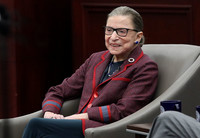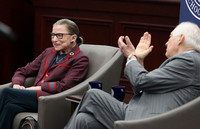A fireside chat with Justice Ginsburg — women’s rights, divisiveness, and hope for America
U.S. Supreme Court Justice Ruth Bader Ginsburg spent Tuesday morning in Bristol, to the delight of a small crowd of adoring fans who gave the liberal icon several standing ovations.
Appearing in …
This item is available in full to subscribers.
Please log in to continue |
Register to post eventsIf you'd like to post an event to our calendar, you can create a free account by clicking here. Note that free accounts do not have access to our subscriber-only content. |
Day pass subscribers
Are you a day pass subscriber who needs to log in? Click here to continue.
A fireside chat with Justice Ginsburg — women’s rights, divisiveness, and hope for America
U.S. Supreme Court Justice Ruth Bader Ginsburg spent Tuesday morning in Bristol, to the delight of a small crowd of adoring fans who gave the liberal icon several standing ovations.
Appearing in the Honorable Bruce M. Selya Appellate Courtroom at the Roger Williams University School of Law, Justice Ginsburg engaged in an hour-long fireside chat with an old friend, the 1st U.S. Circuit Court of Appeals Senior Judge for whom the courtroom was named.
Seated before a crowd of 200 people, primarily law school students and professors, the two jurists talked about Justice Ginsburg’s career, the prejudices and obstacles she faced as a woman in a profession dominated by men, landmark cases in her lifetime, her health, and the current state of political divisiveness in America. Justice Ginsburg was soft-spoken, sincere and often funny, dropping a number of one-liners that sparked loud eruptions of laughter in the packed courtroom.
Following are excerpts from her appearance …
Why she pursued a legal career?
Justice Ginsburg recounted growing up and coming of age during the 1950s, when Sen. Joe McCarthy and others believed there were Communists on every street corner.
“I went to college thinking I would become a history teacher. It was a secure job for a woman,” she said.
She said a very influential Constitutional law professor at Cornell University shaped her views toward what was happening around her. “He wanted me to understand, that we have the right to think, speak, and act as we believe, and not as the people running the government tell us to think,” Justice Ginsburg said.
“Many people, notably from the entertainment community, were being hauled before the House Un-American Activities Committee … and the lawyers representing these people were reminding our Congress that we have a First Amendment, and that we have a Fifth Amendment that protects us against self-incrimination, and I got the idea from that, that being a lawyer was a pretty nifty thing … that you could so something to make this society better.”
On being a woman at Harvard Law School
When she entered law school, she was one of nine women in a class of about 500. She said there were two teaching buildings for the law school. One had a bathroom for women, the other did not. So if you were in the wrong building, you would have to make a mad dash from one to the other, just to go to the bathroom.
“It was a certain challenge,” she said. “We had a huge responsibility. When we were speaking in class, we felt we were not speaking just for us, we were speaking for all women,” Justice Ginsburg said.
Fearing that the men would say, “What do you expect, she’s only a woman,” the women in her law school were often better prepared than the men, she said.
Justice Ginsburg transferred to Columbia University in New York and later graduated tied for first in her class.
On the job market for women in the 1950s
“Employers were up front about not wanting to hire women. There were signup sheets that said, ‘men only,’ ” Justice Ginsburg said.
“I don’t know how many times I was told, by an employer, ‘we had a woman once, and she was dreadful.’ I would say, ‘well, how many men have you had who were dreadful?’ ”
On her teaching career at Rutgers University
The dean told her should would have to take a cut in pay, because it was a state university. She said she expected that, but when the dean told her how much, she was “startled.”
“I asked, ‘how much are you paying so and so,’ a man who had been out of law school about the same about the same amount of time. And the dean’s response was, ‘Ruth, he has a wife and two children to support. Your husband has a good-paying job.’ ”
On her work for the Women’s Rights Project
Justice Ginsburg recounted a number of gender-based cases that came before the U.S. Supreme Court in the years leading up to the 1970s. She recounted the 1961 case Hoyt vs. Florida, brought by a battered woman who murdered her “philandering, abusive husband.”
Ms. Hoyt filed an appeal with the criminal court, which in those days in Florida, did not allow women to serve on juries. “Her argument was, ‘I’m entitled to a jury drawn from a cross-section of the community, and this cross-section excludes half the population.”
The court ultimately decided that if women want to serve on juries, they can go to the court and sign up. “So the message for women was, the men have no choice, they have to serve, but the women are expandable. We don’t need them to take part in the service of justice.”
She said that cases like this, and others, led to a surge in gender-based cases before America’s highest courts, with landmark outcomes. “In the 1970s, the court struck down many laws that discriminated on the basis of gender … By the end of the ’70s, almost all of the explicit gender-based laws were removed.”
On comparisons with Thurgood Marshall
The legendary Thurgood Marshall served on the U.S. Supreme Court and is lauded for his work addressing civil rights in the United States. Some have compared Justice Ginsburg’s influence on women’s rights to Justice Marshall’s influence on civil rights.
Justice Ginsburg does not accept that description.
“My life was never in danger,” she said. “Thurgood Marshall would go to a town in the South, and when he got up in the morning, he never knew if he would be alive at the end of the day.”
On divisiveness in Supreme Court appointments
When President Bill Clinton appointed her to the Supreme Court in 1993, Congress approved Justice Ginsburg by a vote of 96-3. More recently, every appointee has faced significant opposition, with at least 30 percent of Congress opposed.
Justice Selya asked about how that “polarization” will impact the judiciary in America, and whether it is irreversible or temporary.
She recounted her own appointment, when many wanted to question her work on behalf of the American Civil Liberties Union, yet when it came time for an appointment vote, the vast majority supported her.
“Someday I hope we can get back to the way it used to be, in the ’90s,” she said.
“It will take great leaders, on both sides of the aisle, to say ‘let’s stop this nonsense’ and start working for our country again, the way we should.”
On President Jimmy Carter
Justice Ginsburg said President Jimmy Carter never made an appointment to the Supreme Court, but “that president literally changed the complexion of the U.S. judiciary.”
She said President Carter looked at the judiciary during his presidency and said, “ ‘Those judges all look like me.’ They were white, and they were men … So Carter was determined to appoint women and minorities to the federal courts.”
She added that most presidents since then have continued the trend, and the country’s highest courts have changed dramatically in the past 50 years.
On the Dennis Thatcher Society
This “secret” society is named after the husband of former British Prime Minister Margaret Thatcher. Asked about her late husband’s inclusion in the society, Justice Ginsburg described what it is.
“It’s for men whose wives had jobs that, in their heart of hearts, they’d really like to have.”
On her two battles with cancer and her overall health
The 84-year-old Justice Ginsburg has survived both colorectal and pancreatic cancer. Since 1999, she has worked with the same trainer, Bryant Johnson, who recently published a book, “The RBG Workout.”
Asked how she feels, she said, “I feel fine.” The comment triggered loud applause and cheering.
She said many reporters have asked about her routine and want to try it. “Most of them failed miserably,” she laughed.
They also laughed about recent “Saturday Night Live” portrayals of Justice Ginsburg as a vitamin-popping, weight-pumping workout nut who is determined to do anything possible to outlive the Trump Presidency.
On her relationship with Justice Scalia
Until his death in 2006, Justice Antonin Scalia was considered the conservative stalwart on the U.S. Supreme Court, yet he and Justice Ginsburg developed a close relationship and “fondness” for one another.
“I disagreed with a lot of what he said, but I loved the way he said it,” Justice Ginsburg said.
“Even though we were often on opposite sides, we would go over each other’s opinions, and of course I would often say he might want to tone this down to be more persuasive.”
He would point out grammatical errors in her opinions, or give her an advanced look at his opinions. She said there was a mutual respect and fondness at all times.
On the future of political discourse in America
At the end of the program, Justice Ginsburg fielded questions from the audience. One law student asked about the current political climate in America.
Justice Ginsburg said she is hopeful. She referenced the McCarthy period in the 1950s and the “Red Scare.”
“That time has passed. This time will too. We have something so wonderful in this nation, the democracy that exists, it would be tragic to lose it.”
On the Supreme Court reflecting or affecting American society
Justice Ginsburg asserted numerous times that the Supreme Court does not shape American values, it often reflects or reacts to what is already happening. She said society frequently changes, and then the court catches up with that change.
She suggested that the roots of the civil rights gains in the 1960s and ’70s were really planted during World War II.
“I think the beginning of the end of ‘separate but equal’ was our experience during World War II,” she said. “We were fighting a war against racism, and yet our troops, for most of the war, were segregated.”
She talked about the same things happening with gay rights in the ’70s, ’80s and ’90s, and women’s rights during that same period.
‘We the People’
In response to another law student’s question, she talked about a changing America:
“Think of how it was in 1787, when the Constitution was adopted. It starts out ‘We the People.’ And who are ‘we the people’ in 1787? White. Male. And property owners. Over the course of our history, the composition of ‘we the people’ has expanded … The idea of an embracive society, that appreciates our differences, is what can make our nation great.”









